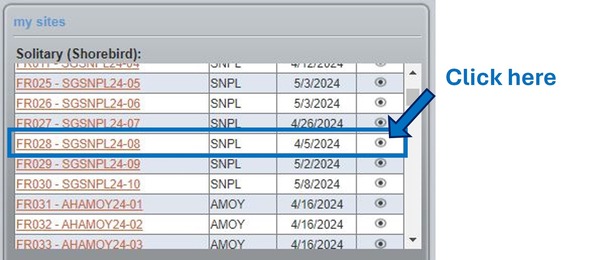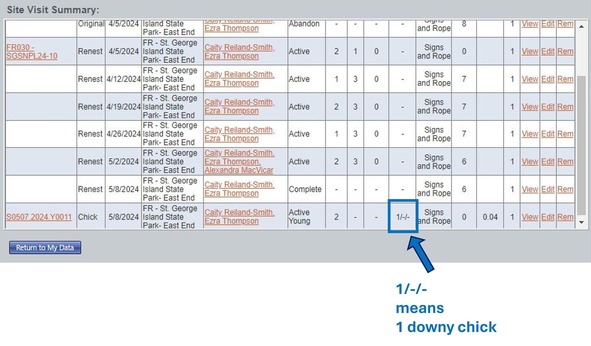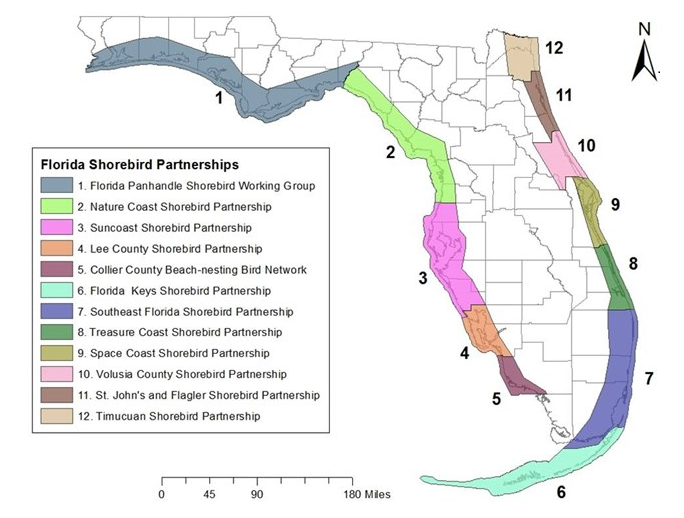|
July 8 - 14. July count window for the Breeding Bird Protocol. Whenever possible,
weekly surveys are preferred for routes with active nesting; it helps capture information
about peak counts.
Fourth of July through the end of nesting season: Beach stewards are needed at important beach nesting sites. Check out the Become a Bird Steward opportunities and get involved!
Tips for a Shorebird-friendly Fourth of July
As people head for the coasts for the Independence Day holiday, the FWC is reminding the public to help protect shorebirds and seabirds by giving them space and keeping personal fireworks off the beach.
It's the peak nesting season for shorebirds, and flightless chicks are common in coastal habitats along Florida’s Atlantic and Gulf coasts. Threatened species such as the snowy plover, least tern, black skimmer and American oystercatcher are among the shorebirds facing conservation challenges and needing help from people to survive. Loud noises can cause adults to flush off their nests and tiny chicks to become separated from parents, leaving them vulnerable to predators, the elements and getting stepped on by beachgoers. Celebrate a shorebird-friendly Independence Day by following these tips:
Leave fireworks to the professionals. Keep personal fireworks off the beach; attend an official event instead. The loud sounds and bright lights of fireworks on Florida's beaches and waterways can have catastrophic effects on nesting birds and their chicks, as well as nesting sea turtles.
Do the flock walk. Keep at least 300 feet from nesting birds, stay out of posted areas, and walk around flocks of birds. Getting too close to nesting shorebirds, seabirds and wading birds can cause them to flush from their breeding sites, leaving vulnerable eggs and chicks exposed to the elements and predators. Egg temperatures can increase to lethal levels after just a few minutes of direct sun exposure. Shorebirds and seabirds nest in shallow scrapes in the sand and their eggs and chicks are well-camouflaged, making them vulnerable to being stepped on unless people look out for them and walk around flocks of birds.
Properly stash all trash. Trash and food scraps attract predators, such as raccoons and crows, that prey on shorebird eggs and chicks. Litter on beaches and in the water can entangle birds, turtles and other wildlife. Beachgoers can help shorebirds and other native wildlife by properly disposing of all trash, filling in human-made holes in the sand, and removing all personal gear from the beach before sunset. Be sure to dispose of fishing line properly - it can be deadly to waterbirds, sea turtles and other wildlife. To find a monofilament recycling station near you, visit mrrp.myfwc.com.
Keep Fido at home. Even well-behaved dogs and responsible people can frighten shorebirds, causing them to abandon their eggs and chicks. Birds see all dogs as predators. If you're visiting a pet-friendly beach, keep your furry friend on a leash.
Look for Critical Wildlife Area (CWA) closures. Be on the lookout for signs designating Critical Wildlife Areas on the beach or coastal islands – these areas are closed to public access to protect high concentrations of wading birds and shorebirds while they nest and raise their chicks. Boaters and beachgoers can help nesting birds by keeping distance and noise volumes low near CWAs.
Practice disturbance-free photography. When taking photos, please take great
care to avoid disturbing the birds, and their nests and chicks. Florida’s wildlife photographers can be important advocates for shorebirds and seabirds when following guidance in the How to Be a Shorebird-friendly Photographer brochure.
Be aware. Shorebirds and seabirds nest in a variety of coastal environments, including beaches, shell rakes and small islands. Solitary nesting shorebirds are very cryptic, so remember to stay far away from posted areas even if you do not see nesting birds.
Spread the word. Let your friends and family know how important it is to give shorebirds space and share the message on social media!
Report disturbance of nesting birds to the FWC’s Wildlife Alert Hotline at 888-404-FWCC (3922) or by texting 847411 (Tip411).
Have a happy Independence Day weekend while sharing the shore!

Helpful Hint: Shorebird Nesting Summaries
Did you know that you can use the Florida Shorebird Database (FSD) to look at shorebird nesting for a particular pair?
Every time you enter nest observations, report re-nests, or include natal nest information for a roving chick, the data can be linked together into a nesting sequence. All you have to do is navigate to the MyData page, find the shorebird nest you're interested in, and click View/Edit.
 On the View My Solitary Site page, you'll see a map showing all of the linked data. Below the map, the Site Summary table shows all of the nesting attempts, the distance between them, and whether each nesting attempt was an original nest or a re-nest. If you need to make any corrections, just click the Edit link.
 Full details about every visit to the nests is shown in the Site Visit Summary table, along with any chick observations linked to the natal nest. You can see the nest status for each visit, the counts reported for the nest, and the number of roving chicks reported. Remember, the Breeding Bird Protocol defines three roving chick age classes, and the table uses a shorthand to present the chicks observed in each:
Downy / Feathered / Flight-capable
For example, the chick observation below is shown in the leftmost slot, indicating that one downy chick was observed during the 5/8/2024 survey.
 Being able to view the complete nesting sequence for a given pair helps you track how they're doing - how many nesting attempts they made, how many chicks hatched and how many chicks fledged.
If you have any questions about viewing nesting summaries or navigating the website, email us at FLShorebirdDatabase@myFWC.com.
12 FSA Partnerships
Did you know the Florida Shorebird Alliance is comprised of 12 local partnerships? If you'd like to learn more and get involved in your local partnership, email Shorebird@MyFWC.com.
You can also join the flock on social media: Florida Shorebird Alliance Facebook Group

|